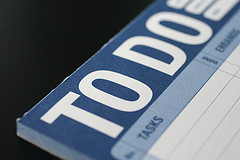
The Perfect Task List
Mondays are productivity days at SimpleProductivity blog.
There are task lists… and there are Task Lists. Most task lists function; but Task Lists actually help you get your work done quicker. So how do you get to the perfect task list?
Let’s start by taking a look at the qualities of the perfect Task List.
The Qualities Of A Perfect Task List
A perfect task list is going to be:
- Limited. A task list should never have so many items on it that you feel overwhelmed just by looking at it. If you can’t look at your list, you won’t be able to work from it.
- Not austere. On the flip side of things, your task list should not contain only one or two items. (Unless, of course, you are completely independent in income and relationships). Too few items and you will fritter your time away.
- Responsive. A task list should be able to show you the tasks that are most relevant to where you are and what you have available to you. You shouldn’t have to wade through piles of tasks you can’t do at the moment. That is just wasting time and energy.
- Easy to access. If you can’t get to it, you can’t use it. If you can’t use it, you won’t be working from it, and you will be relying on memory. And if you’re like most humans, that means you won’t necessarily be working on the stuff that is actually on the list because of your faulty memory.
- Easy to use. Complex systems that require you to turn your tasks upside down, label them and categorize them result in working on the list rather than from the list. This is a subtle trap, because it feels productive, but you’re not actually getting any work done.
- Made of perfect tasks. A task list is just a collection of tasks. As we say in programming, “garbage in, garbage out.” Even should your task list meet the criteria in every other way, filling it with un-doable tasks guarantees you won’t be getting stuff done.
So now that we know the most important thing is perfect tasks, let’s take a look at what the qualities of a perfect Task are.
The Anatomy Of A Perfect Task
A perfect task is going to be:
- Clear. You should be able to tell what to do from the task. “Toilet paper” is not clear. “Refill toilet paper in bathroom” is clear.
- Actionable. It might be clear, but if there is no action to be taken, why is it in your task list?
- Granular. Tasks should be as granular as possible; but note that tasks are rarely made up of a single action. If a bunch of actions are needed to complete a task, and they all happen in the same time and place, it is best to group them together. For example, “refill toilet paper in bathroom” could have the individual steps of “get toilet paper from pantry, remove old roll from spinner, put new roll on spinner.” One action where you know all the steps and complete them at once is best.
- Relevant. Tasks need to be relevant to what you are doing. If someone asks you to do something, you have to consider if it is relevant to your life. “Send Mary recommendation for vet” might be good; “shovel horse muck for John” might not if you have no interest in the horses.
- Measurable. How do you know when your task is done? It has to have a definite, measurable “done” point.
Perfect lists made of perfect tasks. Easy in theory, rather difficult due to our habits.
How does your task list measure up? How about your individual tasks? Share below.




